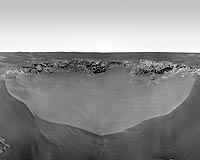Happy anniversary to both Spirit and Opportunity for completing five Earth-years exploring the surface of Mars! Opportunity's goal this past week has been to put the pedal to the metal and acquire drive-by images of a crater dubbed "Ranger Crater."
Preliminary results from last week's shake of the mirror on the miniature thermal emission spectrometer on sol 1771 (Jan. 16, 2009) indicated that no dust was removed as engineers had hoped.
Opportunity is healthy, and all subsystems are performing as expected as of the downlink of information on sol 1776 (Jan. 21, 2009). Solar energy levels are at 613 watt-hours (slightly more than the amount of energy needed to light a 100-watt bulb for six hours).
Tau, a measure of sunlight-blocking dust in the aosphere, is 0.455. The dust factor, a measure of the proportion of sunlight penetrating dust on the solar arrays, is 0.6196.
Sol-by-sol summary
In addition to monitoring daily dust-related changes in aospheric clarity with the panoramic camera and relaying data to NASA's Mars Odyssey orbiter for transmission to Earth, Opportunity completed the following activities:
Sol 1770 (Jan. 15, 2009): Opportunity drove and acquired image mosaics with the navigation and panoramic cameras. The rover measured argon gas in the Martian aosphere using the alpha-particle X-ray spectrometer and went into a mini-deep sleep.Odometry
Sol 1771: Opportunity completed a systematic foreground quarter survey using all 13 color filters of the panoramic camera. The rover checked for drift (changes with time) in the miniature thermal emission spectrometer, conducted a utility test of the instrument, and completed a post-shake test calibration by looking at the ground and sky. Opportunity measured argon gas in the Martian aosphere using the alpha-particle X-ray spectrometer and went into a mini-deep sleep.
Sol 1772: Opportunity surveyed the sky at low Sun with the panoramic camera and, after relaying data to Odyssey, measured argon gas in the Martian aosphere using the alpha-particle X-ray spectrometer. The rover went into a mini-deep sleep.
Sol 1773: Opportunity took morning, thumbnail images of the sky with the panoramic camera and full-color images, using all 13 filters of the panoramic camera, of a target dubbed "Thassos." The rover acquired a 6-by-1 panel of images of pavement textures using the panoramic camera. After measuring argon gas in the Martian aosphere using the alpha-particle X-ray spectrometer, Opportunity went into a mini-deep sleep.
Sol 1774: Opportunity drove 115.36 meters (378.48 feet) and acquired new image mosaics with the navigation and panoramic cameras, including a 360-degree view with the navigation camera. After the day's activities, the rover went into a deep sleep.
Sol 1775: In the morning, Opportunity surveyed the sky at high Sun with the panoramic camera. The rover completed a systematic foreground quarter survey with all 13 color filters of the panoramic camera. After relaying data to Odyssey, Opportunity measured argon gas in the Martian aosphere using the alpha-particle X-ray spectrometer and went into a mini-deep sleep.
Sol 1776 (Jan. 21, 2009): In the morning, Opportunity took spot images of the sky with the panoramic camera for calibration purposes. Opportunity drove 29.90 meters (98.10 feet) to approach Ranger Crater and completed a quick get fine attitude to check the rover's precise location relative to the Sun. The rover acquired new image mosaics with the navigation and panoramic cameras and took a Tau measurement of aospheric dust at sunset. Opportunity then went into a deep sleep. The following morning, Opportunity was to take spot images of the sky for calibration purposes with the panoramic camera, acquire time-lapse movie frames in search of clouds with the navigation camera, and monitor dust accumulation on the panoramic-camera mast assembly.
As of sol 1776 (Jan. 21, 2009), Opportunity's total odometry was 13,866.70 meters (8.62 miles).




Reader Comments
to our Newsletter